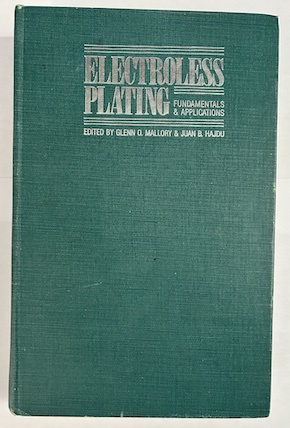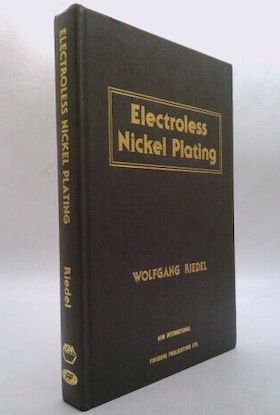
Curated with aloha by
Ted Mooney, P.E. RET

The authoritative public forum
for Metal Finishing 1989-2025

-----
Plating of PZT Ceramics
Q. I have silver paste on ceramic PZT substrate by screen printing method. After firing at 800 °C, blistering appeared.
Thanh Hastudent - Hanoi, Viet Nam
October 12, 2022
⇩ Related postings, oldest first ⇩
Q. I am trying to do thp on a PZT ceramic substrate that has a thin Ti/Au surface layer with holes about 100 microns in diameter. Traditional electroless process doesn't give consistent results. I have been putting a 6-8 micron deposit over the Au prior to wet processing.
Any suggestions?
Thanks
- Issaquah, Washington
1998
A. Gday Mate,
Probably not what you are looking for, some years ago I put together a plating system for titanium on Al2O3 TiBr forms at low temp in Ar is decomposed to Ti at ~1100 ° C.
- Sydney, NSW, Australia
2001
How do you check bonding strength between sputtered metal and ceramic
Q. I am searching for a method to test the bonding strength of Tin over nickel sputtered plating (3500 Angstrom total thickness) on a PZT ceramic substrate. We solder to this sputtered metal and need to know the strength of the bond before and after our solder process. Is there a standard for this? I've heard of a tape pull test, but this doesn't sound very repeatable to me.
Don Loocke- Houston, Texas
2002
A. The tape test is not a perfect test, but it is a very good test when used properly. The strength of the tape and the person who does the test are very key factors. After the part is soldered, you do a simple lead pull test with leads connect to a force scale.
Karl Weyermann- Lebanon, Kentucky
Electroless Nickel plating of PZT Ceramics: Solution turns black and decomposes
Q. We plate EN onto ceramics used in sensors. The ceramic is called lead zirconate titanate (PZT). We etch the ceramics using a weak HCl/HF solution, sensitize with stannous chloride sol'n, seed with palladium chloride sol'n, then immerse in EN bath (hypophosphite process), around 10 minutes. The parts are rinsed with DI water in between solutions. Our parts are small, so we do the process in beakers [beakers on eBay or Amazon [affil links] . Our problem is that after a couple of minutes in the EN bath (70-80 °C), the reaction sometimes seems to accelerate and the bath turns cloudy and black. We've tried making new solutions, and changing soak and rinse times. Any suggestions on where to focus our troubleshooting would be appreciated.
Jim McIntoshceramic sensor mfg - Depew, New York
2007
A. I think you should find out from your supplier if they may have mixed up on the stabilizer products. If you make up new baths and the same results continue, they have made a mistake somewhere.
Rob CoffieWarren, Michigan, USA
|
|
A. Sounds like something is poisoning your beaker. Are you using any air agitation/ Many EN formulations require air agitation to keep the solution from long term self destruction. - Navarre, Florida A. I agree with Mr. Coffie. You bath is becoming unbalanced and unstable at a certain point. The black aspect you mention comes from very fine nickel dust that plates out spontaneously all over the solution instead of only on the part surface. It may be the stabilizers, the complexers or even the sensitizing and seeding steps. This shouldn't happen with a modern commercial chemistry. Are you using a home brew chemistry? Guillermo MarrufoMonterrey, NL, Mexico |
Q. The nickel bath is set up as a double boiler, and we check temp regularly with a digital probe. It does look as if the solution is plating out into itself, not onto the beaker or parts carrier. We do use a home brew, and perhaps one or more of the chemicals has changed such that the solutions we formulate are less stable. We investigated purchased chemistry in the past without success, but perhaps it deserves a second look. Thanks for the inputs.
Jim McIntosh [returning]- Depew, New York
2007
A. It certainly sounds like you have a shortage of the stabilizer component of your home brew.
If you are plating in a beaker, finding someone that will sell to you in small quantities will be a problem. If the big boys will not sell to you in small quantities, check out some of the smaller manufacturers. The stuff has a very long shelf life if kept in a cool dry place, so a 5 gal of each component would not be bad and several companies sell in that quantity.
- Navarre, Florida
A. I have just found your web site and was interested in your problem. It is likely that you are dragging palladium chloride into the bath from your activation process. A few ppm of palladium will cause the bath to de-stabilise causing the reduction of finely divided metallic nickel. Improving the rinsing process may be the key to sorting out your problem.
Regards,
- London, England
A. Piezo electric ceramics have lead as part of the composition. If you are using a mid-phos EN it likely contains a sulfide stabilizer. The stabilizer will quickly be consumed by reacting with the lead in the ceramic, resulting in some black on the ceramic surface and in the solution. The depletion of the sulfur stabilizer will allow black particle plating, and instability of the nickel solution.

Don Baudrand
Consultant - Poulsbo, Washington
(Don is co-author of "Plating on Plastics" [on Amazon or AbeBooks affil links]
and "Plating ABS Plastics" [on Amazon or eBay or AbeBooks affil links])
A. If the EN turns black it means that the solution is decomposing.
Now the question is why, is it because it is a home brew solution which is not stabilized correctly or is it because you drag in something in the solution.
I bet on the first one, solution lacks the fine tuning needed for stabilizing an EN bath. Try to purchase a solution from a supply house and see if the problem still consists.
On the other hand, palladium should be very well rinsed before entering the EN

Sara Michaeli
Tel-Aviv-Yafo, Israel
A. Hur,
Palladium chloride is a very good accelerator. Therefore, must be very good rinsing between pretreatment and the EN. I used a alkaline EN strike before the medium-phosphorous EN.
Best regards,

Anders Sundman
4th Generation Surface Engineering
Consultant - Arvika,
Sweden
April 11, 2015
Nickel Plating PZT Ceramic Nanotubes
-- this entry appended to this thread by editor in lieu of spawning a duplicative threadby Yu Wang & Jorge Santiago-Avilés
on AbeBooks
or Amazon
(affil links)
Q. Looking for a method of coating PZT fired ceramic tube in Nickel. As an approximate size OD 0.80 X ID 0.15 X 6.00 Long.
Sean EvansEngineer - Wrexham, North Wales
March 27, 2015
Clamping a fragile piezo disc for plating
Q. Hello,
I am working on plating the piezo ceramic discs with Ni and Ag. After the electroless plating with Ni, discs are ready to be electroplated with Ag. However, "crocodile" clamping leaves marks after the plating. I've tried very low voltages, replacing the clamps every 10-15 mins (the whole process takes about an hour). Sadly, clamp marks remained. So I was wondering, what is the most simple way to clamp it (or rack it in some other way) in order to achieve a smooth, spotless surface? It is a 12.7 mm wide and 0.4 mm thick fragile disc. The edges of the disc are also plated with Ni, therefore the electric contact exists between bots sides of the disc. I've tried gluing the disc onto copper plate using conductive glue and clamping the plate with "crocodiles", however this did not give me the result I need. Thank you for any suggestions in advance!
Researcher - Kaunas, Lithuania
June 27, 2016
Q, A, or Comment on THIS thread -or- Start a NEW Thread


